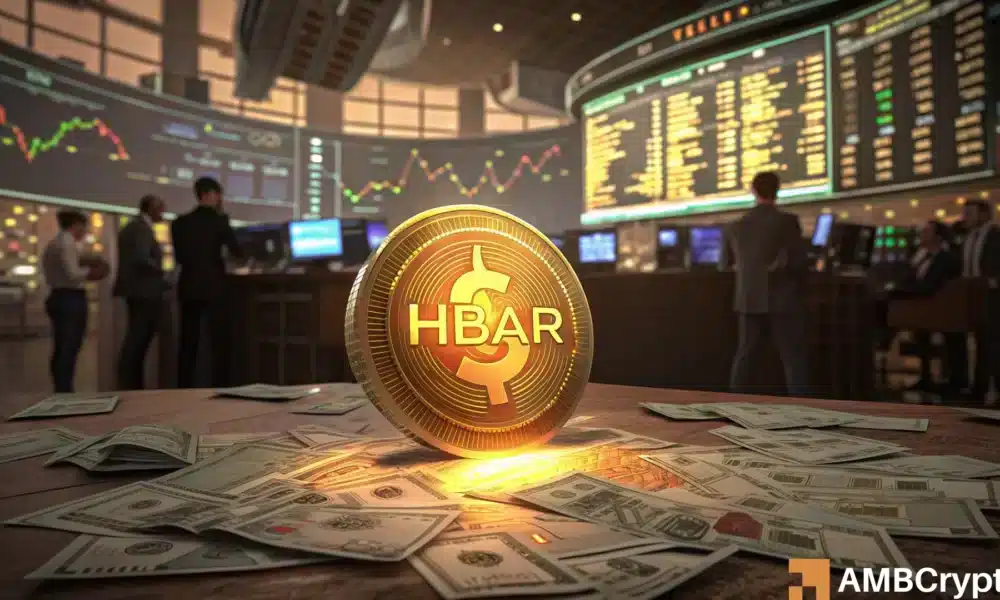
In recent developments, significant filings by investment giants Grayscale and Canary have brought renewed attention to Hedera Hashgraph’s native cryptocurrency, HBAR. These filings for exchange-traded funds (ETFs) signal a growing institutional interest in making HBAR more accessible to traditional investors. As of now, the filings are awaiting approval from regulatory authorities, but the mere prospect of these ETFs has already started generating buzz in the crypto markets, potentially setting the stage for a price rally.
Grayscale, known for its extensive portfolio of cryptocurrency investment products, has been a significant player in bridging the gap between digital assets and institutional investors. Their decision to file for an HBAR ETF suggests a strategic move to offer exposure to one of the market’s most technologically advanced digital currencies. Hedera Hashgraph, with its unique consensus mechanism, offers faster transactions and enhanced security features compared to many blockchain-based cryptocurrencies, making it an attractive option for both institutional and retail investors.
On the other hand, Canary, though less known than Grayscale, has been making strides in the crypto investment space with its innovative approach to digital asset management. Canary’s filing reflects a similar belief in the potential of HBAR to deliver substantial returns, especially in a market that has been increasingly receptive to crypto-backed financial products. Should these ETFs receive approval, they would not only provide liquidity and accessibility to HBAR but could also drive significant capital inflow into the cryptocurrency.
The potential approval of these ETFs comes at a time of heightened regulatory scrutiny in the crypto sector. Governments and regulatory bodies worldwide have been tightening their oversight on digital assets to protect investors and ensure market stability. However, the growing trend of approving crypto ETFs, as seen with recent Bitcoin and Ethereum ETF approvals, suggests a shift towards a more accepting regulatory environment. This could bode well for the approval of HBAR ETFs, aligning with the market’s trajectory toward mainstream adoption.
While the anticipation of these ETFs is causing optimism among HBAR investors, some analysts urge caution. The crypto market is inherently volatile, and the approval of an ETF does not guarantee an immediate or sustained price increase. Historical precedents show that while ETF approvals can lead to short-term price surges, they may not always result in long-term growth. Additionally, market conditions, investor sentiment, and external economic factors will continue to play crucial roles in determining HBAR’s price trajectory.
Moreover, critics of cryptocurrencies often point to the potential risks associated with digital assets, such as market manipulation, lack of intrinsic value, and regulatory uncertainties. These factors could influence the performance of any newly approved HBAR ETF, potentially affecting investor confidence. Furthermore, while institutional interest typically signals positive momentum, it also raises the question of how retail investors might react, especially if they perceive the market as being dominated by larger financial entities.
However, proponents argue that the introduction of HBAR ETFs could provide a more structured and secure investment vehicle for those interested in the cryptocurrency market. ETFs are known for their transparency, ease of trading, and regulatory oversight, which could mitigate some of the risks associated with direct cryptocurrency investments. By facilitating easier access to HBAR, ETFs could expand its investor base and enhance liquidity, ultimately contributing to market stability and maturity.
Another factor to consider is the ongoing development within the Hedera ecosystem itself. As the platform continues to secure partnerships and expand its use cases, the underlying value proposition of HBAR could be further strengthened. Innovative initiatives, such as the integration of Hedera’s technology into enterprise solutions and government projects, could drive organic demand for HBAR, complementing any price movements sparked by ETF activities.
Looking beyond the immediate impact of ETF filings, the broader crypto market dynamics will also play a critical role in shaping HBAR’s future. The continued evolution of blockchain technology, increasing competition among cryptocurrencies, and macroeconomic trends will collectively influence investor behavior and market valuations.
In conclusion, while the filings by Grayscale and Canary have undeniably placed HBAR in the spotlight, the ultimate outcome of these efforts will depend on a complex interplay of regulatory decisions, market conditions, and crypto adoption trends. As the market watches closely for regulatory feedback on these ETFs, investors should remain vigilant, weighing both the opportunities and risks associated with this potential market development.
Overall, the interest from leading financial institutions underscores the growing recognition of cryptocurrencies as viable investment assets. Whether this attention will translate into a sustainable rally for HBAR remains to be seen, but it certainly marks an exciting chapter in its journey towards greater mainstream acceptance. As the crypto landscape continues to evolve, HBAR and other digital currencies will likely play an increasingly significant role in the global financial ecosystem.
Post Views: 120




